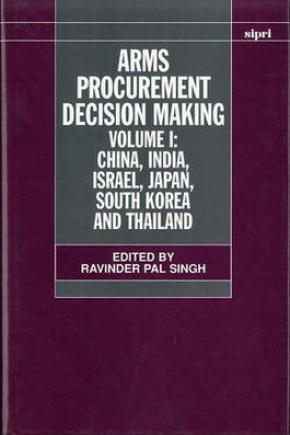Arms Procurement Decision Making Volume I: China, India, Israel, Japan, South Korea and Thailand
The rationale for this SIPRI study was to examine ways in which national arms procurement processes, even though they involve sensitive security issues and complex weapon systems, can become more responsive to the broader objectives of security and public accountability. It is believed that the debate on the need for public accountability of the decision-making processes will contribute to the objectives of arms procurement restraint and, indirectly, to the aims of a stable and durable peace.
It is hoped that an examination of the tension between the public's 'right to know' and the military's interpretation of confidentiality based on an exclusive 'need to know' will provide lessons for other areas of public policy making in which the ruling élite controls and manipulates information. Secrecy, moreover, allows waste, fraud and abuse of power to creep into the policy-making processes.
The project examined arms procurement decision-making processes in six major arms-recipient countries. The criteria for selection included their significance in their respective regions, based on their relative economic potential, size and population; their significance as recipients of conventional arms in the past decade; and the inadequacy of published research on their arms procurement decision-making processes. The study proceeded by organizing workshops and networks of experts in the countries concerned, resulting in 60 research papers on which the six country studies are based. It proved a highly innovative and successful approach for the strengthening of contacts between experts in different countries. The project is funded by the Ford Foundation.
Many other countries could have been included in this study using these criteria. For the second phase of the project, studies are being conducted on Chile, Greece, Malaysia, Poland, South Africa and Taiwan.
-
- Except in Japan, formal processes for long-term threat assessment and coordination between foreign and security policy-making processes are not well organized. Coordination between the Japanese Foreign Ministry and the Japan Defense Agency is broadly based and well institutionalized. Although this may not directly influence arms procurement decisions, it reduces the military's autonomy and broadens the rationality of national defence decision making.
- In Israel, although coordination between the ministries of defence and foreign affairs is at an early stage of development, the Israel Defense Forces' defence plans and arms procurement priorities are closely integrated. In South Korea, coordination of security decision making is transparent, but better developed between the country's military and the USA than between its military and the South Korean Government. In all other countries in this study, coordination between defence and foreign policy is lacking, which may affect the coherence of national security decision making.
- The influence of the military on national security and arms procurement decisions was found to be high in China, Israel, South Korea and Thailand. In India, despite the healthy state of civil-military relations, the military is somewhat insulated from public accountability norms.
- The defence budget design and breakdown of the financial data made available determine how informative published budgets are. In the case of China, parliamentary oversight of the defence budget does not exist except insofar as it is part of the general state budget. In all the other countries such oversight is carried out in a perfunctory manner, except in South Korea, where a better budget design to facilitate parliamentary scrutiny is beginning to take shape.
- Audit, both by the legislature and by professionals, is an essential part of democratic oversight. Departmental audit agencies exist in all the countries, but their levels of competence vary. The study did not identify any statutory audit processes for scrutinizing the arms procurement decisions in China and Thailand. In the case of South Korea, increasing democratization is leading to improvements in statutory audit processes. Israel appears to have the highest standards of multi-disciplinary competence in the Office of the State Comptroller, enabling timely evaluation of arms procurement decisions:
- In all countries except India and Thailand, the agencies for testing, monitoring and evaluation of R&D are independent of those which carry out R&D. In Israel, Japan and South Korea, where applied R&D is conducted in the private sector, technology testing, validation and evaluation are carried out by agencies of the defence ministries.
- The existence of competitive engineering industries in Israel, Japan and South Korea gives these countries greater capacity to manage and integrate technologies developed in the defence and the civilian sectors than in India or in Thailand.
- More often than not, parliamentary opinion on security policies is given low priority by the government and the military, who assume that they know what is best for the security of the country. On the whole, a lack of availability of experts to the legislative oversight processes impedes the creation of capacities for monitoring the government. Legislative oversight is better organized in Israel, despite its military's influence in the national decision-making apparatus owing to the country's strong security concerns.
- Official information and statements of civilian and military officials in China, India, Japan, South Korea and Thailand are traditionally treated with deference. The defence debate in India and Israel is comparatively more developed.
- Arms procurement decisions understandably require a certain degree of confidentiality. The elected representatives need to devise criteria and methods to harmonize those valid requirements with their demands for information for the purposes of oversight.
- The potential contribution of a cadre of inter-disciplinary experts independent of the government in advising legislative oversight bodies in their work in order to create checks and balances on national arms procurement decision making cannot be overemphasized.
- Public accountability of security policies and arms procurement decisions could also encourage accountability in other aspects of public policy-making.
- Major arms-recipient countries with relatively transparent public scrutiny methods have a responsibility to show other countries in their respective regions how accountability norms can be developed to encourage balanced national security decision-making and arms procurement decisions.
- Broader public participation in the national security debate can have a stabilizing influence and can contribute to regional confidence and security building. There is a need to develop regional dialogues to design a code of conduct for arms procurement restraints as a confidence-building initiative.
- Even in established democracies, military institutions, security bureaucracies and defence industrial organizations tend to emphasize their autonomy in defence decision making by controlling information, and resisting public accountability. Public debate is stifled by promoting the belief that military is the only instrument for advancing national. More often than not, defence decision makers overemphasize the need for secrecy by failing to distinguish between the demands for public accountability and the competing requirements of military confidentiality.
1. Introduction
Ravinder Pal Singh
2. China
Chinese Country Study Group
3. India
Ravinder Pal Singh
4. Israel
Gerald Steinberg
5. Japan
Masako Ikegami-Andersson
6. South Korea
Jong Chul Choi
7. Thailand
Panitan Wattanayagorn
8. Comparative analysis
Ravinder Pal Singh
Annexe A. Research questions
Annexe B. Abstracts of the working papers
Annexe C. About the contributors
Index

